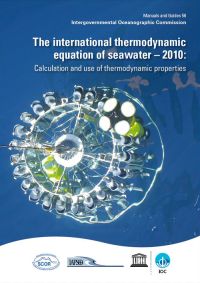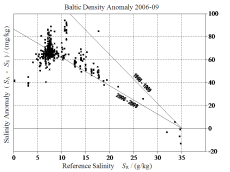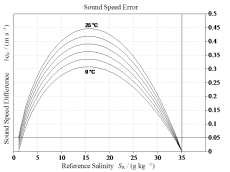
TEOS-10: Thermodynamic Equation Of Seawater - 2010

The new equations of state for seawater thermodynamics, including properties of ice and humid air, were endorsed in 2009 by UNESCO in Paris for all its member states as an international standard for oceanography, to be valid from 2010 on. The document is termed TEOS-10 (International Thermodynamic Equation of Seawater - 2010). The required equations of state for seawater, ice and humid air were developed at the IOW in the years 2002-2009, and implemented as a part of a comprehensive software library package.
To support and accompany the practical transition of the scientific work at the institutes worldwide from the previous standard of 1980, “EOS-80” to TEOS-10, an internet toolbox www.teos-10.org was created by the SCOR/IAPSO Working Group 127 in November 2010 to freely provide the users with comprehensive descriptions, background material and software source code.
This includes
- The actual standard document on TEOS-10 (TEOS-10 Manual), a manual with about 200 pages issued by UNESCO/Paris, as well as a short introduction “what every oceanographer should know about TEOS-10” (TEOS-10 Primer)
- The TEOS-10 libraries, SIA (Sea-Ice-Air) in VBA for Excel spreadsheet applications and in Fortran, as well as GSW (GibbsSeaWater) in Matlab
- All relevant scientific background articles on the properties of water, vapour, ice, seawater and air as well as on the definition of salinity
- The official standards of the International Association for the Properties of Water and Steam (IAPWS) on water, ice, seawater and humid air, which form the Primary Standard of TEOS-10
- Data and equations for the description of composition anomalies of the Baltic Sea and the world ocean, and for the related properties
- Popular-scientific explanations of TEOS-10
The results of densitometer measurements in the Baltic Sea during 2006-2009, converted to Absolute Salinity anomalies published in www.ocean-sci.net/6/3/2010/. Symbol “x”: filtered samples, “u”: unfiltered samples. 436 samples with salinity > 2 g kg –1 were used for the fit. At vanishing Reference Salinity SR, the limiting anomaly is . There is no significant systematic difference between the fits using the data from filtered or unfiltered samples; the intercept is 87.0 mg/kg for only the 168 filtered “x” samples, and 86.6 mg/kg for only the 270 unfiltered “u” samples. The line marked 1966-1969 is the regression line with regard to the data from 1966-69 of Millero and Kremling (1976).
Error in sound speed, if computed from measured Reference Salinity using the Gibbs function for SSW. Results are shown for temperatures between 0 and 25 °C and at atmospheric pressure.

